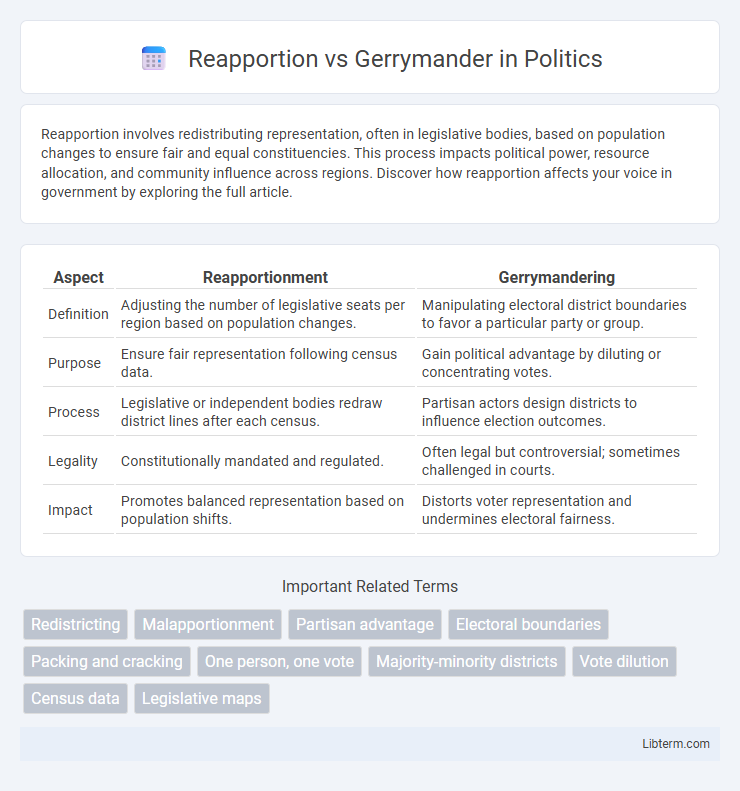Reapportion involves redistributing representation, often in legislative bodies, based on population changes to ensure fair and equal constituencies. This process impacts political power, resource allocation, and community influence across regions. Discover how reapportion affects your voice in government by exploring the full article.
Table of Comparison
| Aspect | Reapportionment | Gerrymandering |
|---|---|---|
| Definition | Adjusting the number of legislative seats per region based on population changes. | Manipulating electoral district boundaries to favor a particular party or group. |
| Purpose | Ensure fair representation following census data. | Gain political advantage by diluting or concentrating votes. |
| Process | Legislative or independent bodies redraw district lines after each census. | Partisan actors design districts to influence election outcomes. |
| Legality | Constitutionally mandated and regulated. | Often legal but controversial; sometimes challenged in courts. |
| Impact | Promotes balanced representation based on population shifts. | Distorts voter representation and undermines electoral fairness. |
Understanding Reapportionment: Definition and Purpose
Reapportionment is the process of redistributing seats in a legislative body based on population changes identified by the decennial census, ensuring equal representation for growing or shrinking populations. Unlike gerrymandering, which involves manipulating district boundaries to favor a political party, reapportionment strictly addresses the fair allocation of seats to reflect demographic shifts. This process maintains the constitutional principle of "one person, one vote" by adjusting representation in the House of Representatives according to updated census data.
What is Gerrymandering? A Brief Overview
Gerrymandering is the manipulation of electoral district boundaries to favor a specific political party or group, often resulting in distorted representation. This practice involves drawing irregular or biased district lines to concentrate or dilute voting power, undermining the principle of fair elections. Gerrymandering contrasts with reapportionment, which is the legal redistribution of seats based on population changes reflected in the census.
Historical Background of Reapportionment in the U.S.
The historical background of reapportionment in the U.S. dates back to the Constitution's mandate to redistribute congressional seats based on decennial census data, ensuring representation reflects population shifts. Early apportionment acts from 1790 onward established the framework for allocating House seats, adapting to the nation's growing and migrating populace. Over time, reapportionment has faced challenges and reforms to address malapportionment and maintain equitable representation amid evolving demographics.
Types of Gerrymandering: Partisan, Racial, and Beyond
Gerrymandering manipulates electoral district boundaries to favor specific political parties or groups, with partisan gerrymandering aiming to secure political dominance and racial gerrymandering diluting minority voting power, often violating Equal Protection Clause standards. Beyond these, there are incumbent gerrymandering strategies designed to protect current officeholders and bipartisan gerrymandering that sets districts to discourage electoral competition. These tactics contrast with reapportionment, which adjusts district boundaries based strictly on population changes derived from census data, aiming for equal representation without political bias.
Legal Framework: Laws Governing Reapportionment and Gerrymandering
The legal framework governing reapportionment is primarily based on the principle of "one person, one vote," established by the U.S. Supreme Court in cases like Reynolds v. Sims (1964), ensuring legislative districts have equal populations. Gerrymandering laws, however, address the manipulation of district boundaries to favor specific political parties or groups, with recent rulings such as Rucho v. Common Cause (2019) limiting federal courts' ability to intervene in partisan gerrymandering while still allowing challenges for racial gerrymandering under the Voting Rights Act. State laws and independent redistricting commissions also play a critical role in regulating both reapportionment and gerrymandering processes to promote fairness and compliance with constitutional mandates.
Key Differences Between Reapportionment and Gerrymandering
Reapportionment involves the allocation of legislative seats based on population changes identified by the census, ensuring equal representation across districts. Gerrymandering manipulates district boundaries to favor a particular political party or group, often undermining fair representation. The key difference lies in reapportionment's objective of equitable seat distribution, while gerrymandering intentionally distorts district shapes to influence electoral outcomes.
Impacts of Reapportionment on Representation
Reapportionment directly affects political representation by redistributing congressional seats based on population changes recorded in the decennial census, ensuring each district reflects demographic shifts and population growth or decline. This process strives to maintain equal representation across states, preventing over- or under-representation in the House of Representatives. However, reapportionment outcomes can influence political power dynamics, often prompting strategic redistricting efforts that impact local and national legislative priorities.
How Gerrymandering Distorts Electoral Outcomes
Gerrymandering distorts electoral outcomes by manipulating district boundaries to favor a political party, often resulting in disproportionate representation that does not reflect the popular vote. This practice can dilute the voting power of certain demographic groups, leading to uncompetitive districts and reduced voter influence. Unlike reapportionment, which reallocates seats based on population changes, gerrymandering intentionally engineers electoral maps to entrench incumbents and skew political power.
Recent Court Cases and Landmark Decisions
Recent court cases such as Rucho v. Common Cause (2019) highlight the Supreme Court's stance that claims of partisan gerrymandering present political questions beyond federal courts' reach. Landmark decisions like Baker v. Carr (1962) established the justiciability of redistricting cases, enabling judicial review of reapportionment challenges. Ongoing litigation continues to address the balance between fair representation and political influence in redistricting processes.
Reform Efforts: Combating Gerrymandering and Promoting Fair Maps
Reform efforts targeting gerrymandering focus on establishing independent redistricting commissions and implementing algorithmic mapping tools to create fair and competitive electoral districts. Legislation like the For the People Act aims to increase transparency and limit partisan influence in the redistricting process. States such as California and Arizona have pioneered these reforms, resulting in more balanced representation and enhanced voter confidence in electoral outcomes.
Reapportion Infographic

 libterm.com
libterm.com